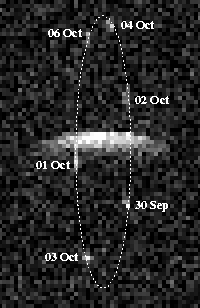Loading AI tools
From Wikipedia, the free encyclopedia
(185851) 2000 DP107 is a sub-kilometer sized asteroid, classified as potentially hazardous asteroid and near-Earth object of the Apollo group that is notable because it provided evidence for binary asteroids in the near-Earth population. The PROCYON probe developed by JAXA and the University of Tokyo was intended to flyby this asteroid before its ion thruster failed and could not be restarted.
 Composite of radar images by the Arecibo Observatory from September to October 2000 | |
| Discovery[1] | |
|---|---|
| Discovered by | LINEAR |
| Discovery site | Lincoln Lab's ETS |
| Discovery date | 29 February 2000 |
| Designations | |
| (185851) 2000 DP107 | |
| 2000 DP107 | |
| NEO · PHA · Apollo[1][2] | |
| Orbital characteristics[2] | |
| Epoch 4 September 2017 (JD 2458000.5) | |
| Uncertainty parameter 0 | |
| Observation arc | 16.82 yr (6,143 days) |
| Aphelion | 1.8794 AU |
| Perihelion | 0.8511 AU |
| 1.3652 AU | |
| Eccentricity | 0.3766 |
| 1.60 yr (583 days) | |
| 255.78° | |
| 0° 37m 4.44s / day | |
| Inclination | 8.6718° |
| 358.70° | |
| 289.74° | |
| Known satellites | 1 |
| Earth MOID | 0.0150 AU · 5.8 LD |
| Physical characteristics | |
| Dimensions | 0.860 km (taken)[3] 0.863±0.043 km[4] 1.0±0.1 km[5] |
| 2.769±0.005 h[6] 2.774±0.001 h[7] 2.77447±0.00005 h[8] 2.7745±0.0007 h[4] 2.7754±0.0002 h[9] 2.7754 h[10] | |
| 0.111±0.036[5] 0.15 (derived)[3] | |
| M[11] · C[3][12] | |
| 18.0[10] · 18.0±0.2 (R)[6] · 18.02±0.2[3][13] · 18.03±0.1[5] · 18.2[2] | |
The asteroid was discovered on 29 February 2000, by the Lincoln Near-Earth Asteroid Research (LINEAR) program at Lincoln Laboratory's Experimental Test Site, near Socorro, New Mexico.[1]
The binary nature of this asteroid was suggested from radar observations taken with the Goldstone radar antenna on September 22 and 23, 2000, based on an observing proposal by J.-L. Margot and observations by S. J. Ostro and colleagues.[14] Confirming observations were obtained with the Arecibo telescope from September 30 to October 7, 2000.[15]
2000 DP107 orbits the Sun at a distance of 0.9–1.9 AU once every 19 months (583 days). Its orbit has an eccentricity of 0.38 and an inclination of 9° with respect to the ecliptic.[2] The body's observation arc begins with its official discovery observation, as no precoveries were taken, and no prior identifications were made.[1]
The 800-meter-diameter primary and the 300-meter-diameter secondary orbit each other with a separation of 2.6 kilometers and a period of 1.76 days.[16]
The primary is spheroidal and is spinning at a rate near the breakup point for strengthless bodies. These two features were observed in multiple binary systems, suggesting that near-Earth asteroid binaries form by a mechanism involving spin-up and mass shedding.[16] Currently the most generally accepted spin-up mechanism is the YORP effect.
The asteroid is characterized as both a carbonaceous C-type[12] and metallic M-type asteroid.[11]
The density of the primary was calculated using the orbital elements of the binary system, the primary-to-secondary mass ratio, and estimates of the primary size. The primary has a low density of 1.7 g/cm3, which may indicate a "rubble pile" structure containing rocks and voids.
This minor planet was numbered by the Minor Planet Center on 20 May 2008.[17] As of 2018, it has not been named.[1]
Seamless Wikipedia browsing. On steroids.
Every time you click a link to Wikipedia, Wiktionary or Wikiquote in your browser's search results, it will show the modern Wikiwand interface.
Wikiwand extension is a five stars, simple, with minimum permission required to keep your browsing private, safe and transparent.